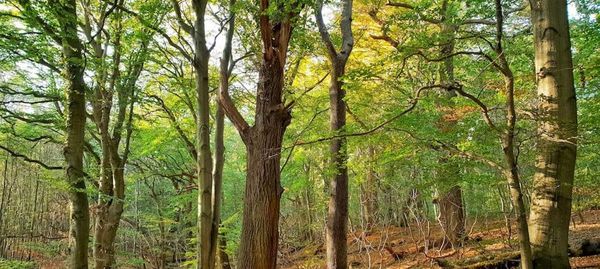Eye For Film >> Movies >> The Hidden Life Of Trees (2020) Film Review
The Hidden Life Of Trees
Reviewed by: Jennie Kermode

In 2020, an Ethiopian project aimed at tackling climate change planted around five billion trees. A similar programme in India planted 250 million. These projects are vital but can't solve the problem on their own, and not jut because the burning of the Amazon rainforest now means that those trees are no pumping out more carbon than they're drawing in. They simply don't have the same value as ancient, virgin forest, and this film, based on the book by German forester Peter Wohlleben, explains why.
We see Wohlleben in the forest in the opening scenes, one of a series of curiously framed moments in which he records an educational video on his phone whilst we watch him through another camera, the phone image included as an inset. He's examining an old tree stump on the forest floor, peeling back moss to reveal that, underneath, there's living tree tissue. How is it surviving without leaves to enable photosynthesis? The answer is that it's not having to cope alone. It's part of a community, and other trees in its social group are parting with some of other own sap in order to feed it.
When one understands how social trees are, Wohlleben explains, one starts to think of the forest as a single lifeform, like a beehive or ants' nest. He will go on to demonstrate how other organisms, such as fungi, also have roles to play in this (though there's a lot more to be said on that score, and interested viewers might want to check out the documentary Fantastic Fungi). He goes on to challenge the popular conception of trees as little different from rocks, extrapolating from familiar facts to show how they observe the world around them, how they identify and fight back against various assailants, how they have a sense of time, and how they communicate.
Two things make this hard for us to recognise most of the time. The first is that trees do everything much, much more slowly than us - but then, we know that some of them can live for thousands of years. The second is that most of the trees we see around us are orphans - cut off from any kind of support system - and are, in a sense, brain damaged, in that their roots have been cut back to enable easy transportation, as a result of which they will never properly engage with their surroundings. Most such trees die prematurely, never getting anywhere close to their potential.
Soil structures add o the problem, especially where soil has been compacted by human activity, damaging its complex hierarchy of microorganisms and cutting off sources of water. Again, this is not discussed in depth - more than enough could be said about it for a film of its own - but this film provides a useful introduction which might inspire viewers to find out more. Wohlleben has made numerous YouTube videos on related subjects. Here, such details, which might seem obscure, are put into context, helping us to understand how they relate to much more dramatic things like weather systems and forest fires. We are shown something of the origins of virgin forests' famous resilience, and we see how vulnerable their replacements are, where replacements are made at all.
It's not all doom and gloom. Recovery is possible, we are assured - but on the forest's timescale. Two to five hundred yeas from now the picture might look very different, if we start, now, to provide forests with proper care.
The Hidden Life Of Trees sets out to engineer a paradigm shift in the minds of viewers. Open yourself to it and not only will you understand forests differently, you'll never take a piece of wooden furniture for granted again.
Reviewed on: 16 Jul 2021















